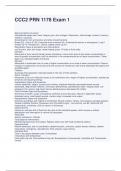Exam (elaborations)
CCC2 PRN 1178 Exam 1 QUESTION AND ANSWERS 2024/2025
- Course
- Institution
CCC2 PRN 1178 Exam 1 QUESTION AND ANSWERS 2024/2025CCC2 PRN 1178 Exam 1 QUESTION AND ANSWERS 2024/2025CCC2 PRN 1178 Exam 1 QUESTION AND ANSWERS 2024/2025CCC2 PRN 1178 Exam 1 QUESTION AND ANSWERS 2024/2025CCC2 PRN 1178 Exam 1 QUESTION AND ANSWERS 2024/2025CCC2 PRN 1178 Exam 1 QUESTION AND ANSWERS 20...
[Show more]



